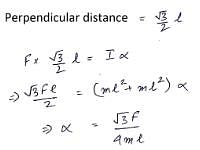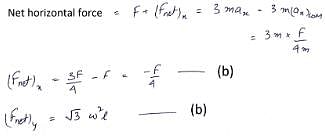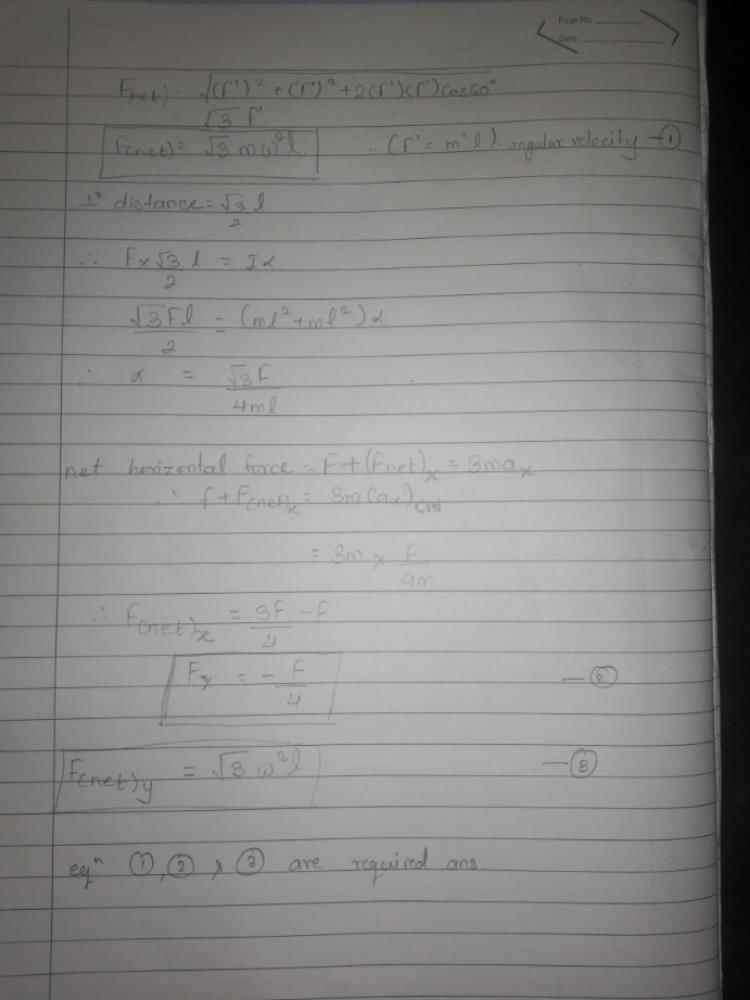Class 11 Exam > Class 11 Questions > Three particles A, B and C, each of mass m, a...
Start Learning for Free
Three particles A, B and C, each of mass m, are connected to each other by three massless rigid rods to form a rigid, equilateral triangular body of side l. This body is placed on a horizontal frictionless table (x-y plane) and is hinged to it at the point A so that it can move without friction about the vertical axis through A (see figure). The body is set into rotational motion on the table about A with a constant angular velocity w.
[JEE'(Scr) 2002]
(a) Find the magnitude of the horizontal force exerted by the hinge on the body
(b) At time T, when the side BC is parallel to the x-axis, a force F is applied on B along BC (as shown). Obtain the x-component and the y-component of the force exterted by the hinge on the body, immediately after time T.
Correct answer is '(a) m w2 l, (b) Fx = F/4, Fy = m w2 l'. Can you explain this answer?
| FREE This question is part of | Download PDF Attempt this Test |
Verified Answer
Three particles A, B and C, each of mass m, are connected to each othe...
ATQ

Now,

So,

Hence the answers should be changed to the ones in the solution marked as (a) and (b)

Now,

So,

Hence the answers should be changed to the ones in the solution marked as (a) and (b)
Most Upvoted Answer
Three particles A, B and C, each of mass m, are connected to each othe...

Free Test
FREE
| Start Free Test |
Community Answer
Three particles A, B and C, each of mass m, are connected to each othe...
ATQ

Now,

So,

Hence the answers should be changed to the ones in the solution marked as (a) and (b)

Now,

So,

Hence the answers should be changed to the ones in the solution marked as (a) and (b)
Attention Class 11 Students!
To make sure you are not studying endlessly, EduRev has designed Class 11 study material, with Structured Courses, Videos, & Test Series. Plus get personalized analysis, doubt solving and improvement plans to achieve a great score in Class 11.

|
Explore Courses for Class 11 exam
|

|
Similar Class 11 Doubts
Three particles A, B and C, each of mass m, are connected to each other by three massless rigid rods to form a rigid, equilateral triangular body of sidel. This body is placed on a horizontal frictionless table (x-y plane) and is hinged to it at the point A so that it can move without friction about the vertical axis through A (see figure). The body is set into rotational motion on the table about A with a constant angular velocity w. [JEE(Scr) 2002](a) Find the magnitude of the horizontal force exerted by the hinge on the body(b) At time T, when the side BC is parallel to the x-axis, a force F is applied on B along BC (as shown). Obtain the x-component and the y-component of the force exterted by the hinge on the body, immediately after time T.Correct answer is '(a) m w2 l, (b) Fx = F/4, Fy = m w2 l'. Can you explain this answer?
Question Description
Three particles A, B and C, each of mass m, are connected to each other by three massless rigid rods to form a rigid, equilateral triangular body of sidel. This body is placed on a horizontal frictionless table (x-y plane) and is hinged to it at the point A so that it can move without friction about the vertical axis through A (see figure). The body is set into rotational motion on the table about A with a constant angular velocity w. [JEE(Scr) 2002](a) Find the magnitude of the horizontal force exerted by the hinge on the body(b) At time T, when the side BC is parallel to the x-axis, a force F is applied on B along BC (as shown). Obtain the x-component and the y-component of the force exterted by the hinge on the body, immediately after time T.Correct answer is '(a) m w2 l, (b) Fx = F/4, Fy = m w2 l'. Can you explain this answer? for Class 11 2024 is part of Class 11 preparation. The Question and answers have been prepared according to the Class 11 exam syllabus. Information about Three particles A, B and C, each of mass m, are connected to each other by three massless rigid rods to form a rigid, equilateral triangular body of sidel. This body is placed on a horizontal frictionless table (x-y plane) and is hinged to it at the point A so that it can move without friction about the vertical axis through A (see figure). The body is set into rotational motion on the table about A with a constant angular velocity w. [JEE(Scr) 2002](a) Find the magnitude of the horizontal force exerted by the hinge on the body(b) At time T, when the side BC is parallel to the x-axis, a force F is applied on B along BC (as shown). Obtain the x-component and the y-component of the force exterted by the hinge on the body, immediately after time T.Correct answer is '(a) m w2 l, (b) Fx = F/4, Fy = m w2 l'. Can you explain this answer? covers all topics & solutions for Class 11 2024 Exam. Find important definitions, questions, meanings, examples, exercises and tests below for Three particles A, B and C, each of mass m, are connected to each other by three massless rigid rods to form a rigid, equilateral triangular body of sidel. This body is placed on a horizontal frictionless table (x-y plane) and is hinged to it at the point A so that it can move without friction about the vertical axis through A (see figure). The body is set into rotational motion on the table about A with a constant angular velocity w. [JEE(Scr) 2002](a) Find the magnitude of the horizontal force exerted by the hinge on the body(b) At time T, when the side BC is parallel to the x-axis, a force F is applied on B along BC (as shown). Obtain the x-component and the y-component of the force exterted by the hinge on the body, immediately after time T.Correct answer is '(a) m w2 l, (b) Fx = F/4, Fy = m w2 l'. Can you explain this answer?.
Three particles A, B and C, each of mass m, are connected to each other by three massless rigid rods to form a rigid, equilateral triangular body of sidel. This body is placed on a horizontal frictionless table (x-y plane) and is hinged to it at the point A so that it can move without friction about the vertical axis through A (see figure). The body is set into rotational motion on the table about A with a constant angular velocity w. [JEE(Scr) 2002](a) Find the magnitude of the horizontal force exerted by the hinge on the body(b) At time T, when the side BC is parallel to the x-axis, a force F is applied on B along BC (as shown). Obtain the x-component and the y-component of the force exterted by the hinge on the body, immediately after time T.Correct answer is '(a) m w2 l, (b) Fx = F/4, Fy = m w2 l'. Can you explain this answer? for Class 11 2024 is part of Class 11 preparation. The Question and answers have been prepared according to the Class 11 exam syllabus. Information about Three particles A, B and C, each of mass m, are connected to each other by three massless rigid rods to form a rigid, equilateral triangular body of sidel. This body is placed on a horizontal frictionless table (x-y plane) and is hinged to it at the point A so that it can move without friction about the vertical axis through A (see figure). The body is set into rotational motion on the table about A with a constant angular velocity w. [JEE(Scr) 2002](a) Find the magnitude of the horizontal force exerted by the hinge on the body(b) At time T, when the side BC is parallel to the x-axis, a force F is applied on B along BC (as shown). Obtain the x-component and the y-component of the force exterted by the hinge on the body, immediately after time T.Correct answer is '(a) m w2 l, (b) Fx = F/4, Fy = m w2 l'. Can you explain this answer? covers all topics & solutions for Class 11 2024 Exam. Find important definitions, questions, meanings, examples, exercises and tests below for Three particles A, B and C, each of mass m, are connected to each other by three massless rigid rods to form a rigid, equilateral triangular body of sidel. This body is placed on a horizontal frictionless table (x-y plane) and is hinged to it at the point A so that it can move without friction about the vertical axis through A (see figure). The body is set into rotational motion on the table about A with a constant angular velocity w. [JEE(Scr) 2002](a) Find the magnitude of the horizontal force exerted by the hinge on the body(b) At time T, when the side BC is parallel to the x-axis, a force F is applied on B along BC (as shown). Obtain the x-component and the y-component of the force exterted by the hinge on the body, immediately after time T.Correct answer is '(a) m w2 l, (b) Fx = F/4, Fy = m w2 l'. Can you explain this answer?.
Solutions for Three particles A, B and C, each of mass m, are connected to each other by three massless rigid rods to form a rigid, equilateral triangular body of sidel. This body is placed on a horizontal frictionless table (x-y plane) and is hinged to it at the point A so that it can move without friction about the vertical axis through A (see figure). The body is set into rotational motion on the table about A with a constant angular velocity w. [JEE(Scr) 2002](a) Find the magnitude of the horizontal force exerted by the hinge on the body(b) At time T, when the side BC is parallel to the x-axis, a force F is applied on B along BC (as shown). Obtain the x-component and the y-component of the force exterted by the hinge on the body, immediately after time T.Correct answer is '(a) m w2 l, (b) Fx = F/4, Fy = m w2 l'. Can you explain this answer? in English & in Hindi are available as part of our courses for Class 11.
Download more important topics, notes, lectures and mock test series for Class 11 Exam by signing up for free.
Here you can find the meaning of Three particles A, B and C, each of mass m, are connected to each other by three massless rigid rods to form a rigid, equilateral triangular body of sidel. This body is placed on a horizontal frictionless table (x-y plane) and is hinged to it at the point A so that it can move without friction about the vertical axis through A (see figure). The body is set into rotational motion on the table about A with a constant angular velocity w. [JEE(Scr) 2002](a) Find the magnitude of the horizontal force exerted by the hinge on the body(b) At time T, when the side BC is parallel to the x-axis, a force F is applied on B along BC (as shown). Obtain the x-component and the y-component of the force exterted by the hinge on the body, immediately after time T.Correct answer is '(a) m w2 l, (b) Fx = F/4, Fy = m w2 l'. Can you explain this answer? defined & explained in the simplest way possible. Besides giving the explanation of
Three particles A, B and C, each of mass m, are connected to each other by three massless rigid rods to form a rigid, equilateral triangular body of sidel. This body is placed on a horizontal frictionless table (x-y plane) and is hinged to it at the point A so that it can move without friction about the vertical axis through A (see figure). The body is set into rotational motion on the table about A with a constant angular velocity w. [JEE(Scr) 2002](a) Find the magnitude of the horizontal force exerted by the hinge on the body(b) At time T, when the side BC is parallel to the x-axis, a force F is applied on B along BC (as shown). Obtain the x-component and the y-component of the force exterted by the hinge on the body, immediately after time T.Correct answer is '(a) m w2 l, (b) Fx = F/4, Fy = m w2 l'. Can you explain this answer?, a detailed solution for Three particles A, B and C, each of mass m, are connected to each other by three massless rigid rods to form a rigid, equilateral triangular body of sidel. This body is placed on a horizontal frictionless table (x-y plane) and is hinged to it at the point A so that it can move without friction about the vertical axis through A (see figure). The body is set into rotational motion on the table about A with a constant angular velocity w. [JEE(Scr) 2002](a) Find the magnitude of the horizontal force exerted by the hinge on the body(b) At time T, when the side BC is parallel to the x-axis, a force F is applied on B along BC (as shown). Obtain the x-component and the y-component of the force exterted by the hinge on the body, immediately after time T.Correct answer is '(a) m w2 l, (b) Fx = F/4, Fy = m w2 l'. Can you explain this answer? has been provided alongside types of Three particles A, B and C, each of mass m, are connected to each other by three massless rigid rods to form a rigid, equilateral triangular body of sidel. This body is placed on a horizontal frictionless table (x-y plane) and is hinged to it at the point A so that it can move without friction about the vertical axis through A (see figure). The body is set into rotational motion on the table about A with a constant angular velocity w. [JEE(Scr) 2002](a) Find the magnitude of the horizontal force exerted by the hinge on the body(b) At time T, when the side BC is parallel to the x-axis, a force F is applied on B along BC (as shown). Obtain the x-component and the y-component of the force exterted by the hinge on the body, immediately after time T.Correct answer is '(a) m w2 l, (b) Fx = F/4, Fy = m w2 l'. Can you explain this answer? theory, EduRev gives you an
ample number of questions to practice Three particles A, B and C, each of mass m, are connected to each other by three massless rigid rods to form a rigid, equilateral triangular body of sidel. This body is placed on a horizontal frictionless table (x-y plane) and is hinged to it at the point A so that it can move without friction about the vertical axis through A (see figure). The body is set into rotational motion on the table about A with a constant angular velocity w. [JEE(Scr) 2002](a) Find the magnitude of the horizontal force exerted by the hinge on the body(b) At time T, when the side BC is parallel to the x-axis, a force F is applied on B along BC (as shown). Obtain the x-component and the y-component of the force exterted by the hinge on the body, immediately after time T.Correct answer is '(a) m w2 l, (b) Fx = F/4, Fy = m w2 l'. Can you explain this answer? tests, examples and also practice Class 11 tests.

|
Explore Courses for Class 11 exam
|

|
Suggested Free Tests
Signup for Free!
Signup to see your scores go up within 7 days! Learn & Practice with 1000+ FREE Notes, Videos & Tests.
























